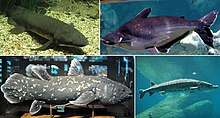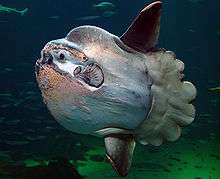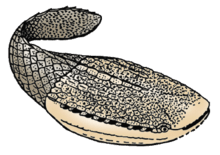Osteichthyes
| Osteichthyes | |
|---|---|
 | |
| Example of Osteichthyes: Queensland lungfish and West Indian Ocean coelacanth (two Sarcopterygii), Iridescent shark and American black sturgeon (two Actinopterygii). | |
| Scientific classification | |
| Kingdom: | Animalia |
| Phylum: | Chordata |
| Clade: | Teleostomi |
| Superclass: | Osteichthyes Huxley, 1880 |
| Groups included | |
| |
| Cladistically included but traditionally excluded taxa | |
Osteichthyes (/ˌɒstiˈɪkθiiːz/), popularly referred to as the bony fish, is a diverse taxonomic group of fish that have skeletons primarily composed of bone tissue, as opposed to cartilage. The vast majority of fish are members of Osteichthyes, which is an extremely diverse and abundant group consisting of 45 orders, and over 435 families and 28,000 species.[1] It is the largest class of vertebrates in existence today. The group Osteichthyes is divided into the ray-finned fish (Actinopterygii) and lobe-finned fish (Sarcopterygii). The oldest known fossils of bony fish are about 420 million years old, which are also transitional fossils, showing a tooth pattern that is in between the tooth rows of sharks and bony fishes.[2]
Osteichthyes can be compared to Euteleostomi. In paleontology the terms are synonymous. In ichthyology the difference is that Euteleostomi presents a cladistic view which includes the terrestrial tetrapods that evolved from lobe-finned fish. Until recently, the view of most ichthyologists has been that Osteichthyes were paraphyletic and include only fishes.[3] However, since 2013 widely cited ichthyology papers have been published with phylogenetic trees that treat the Osteichthyes as a clade including tetrapods.[4][5][6][3]
Characteristics

Bony fish are characterized by a relatively stable pattern of cranial bones, rooted, medial insertion of mandibular muscle in the lower jaw. The head and pectoral girdles are covered with large dermal bones. The eyeball is supported by a sclerotic ring of four small bones, but this characteristic has been lost or modified in many modern species. The labyrinth in the inner ear contains large otoliths. The braincase, or neurocranium, is frequently divided into anterior and posterior sections divided by a fissure.
Early bony fish had simple lungs (a pouch on either side of the esophagus) which helped them breathe in low-oxygen water. In many bony fish these have evolved into swim bladders, which help the body create a neutral balance between sinking and floating. (The lungs of amphibians, reptiles, birds, and mammals were inherited from their bony fish ancestors.)[12][13][14] They do not have fin spines, but instead support the fin with lepidotrichia (bone fin rays). They also have an operculum, which helps them breathe without having to swim.
Bony fish have no placoid scales. Mucus glands coat the body. Most have smooth and overlapping ganoid, cycloid or ctenoid scales.
Classification
Fishes of the World (5th ed) [3]
Traditionally, Osteichthyes was considered a class, recognised on the presence of a swim bladder, only three pairs of gill arches hidden behind a bony operculum, and a predominately bony skeleton.[15] Under this classification system, Osteichthyes was considered paraphyletic with regard to land vertebrates, as the common ancestor of all osteichthyans includes tetrapods amongst its descendants. While the largest subclass, Actinopterygii (ray-finned fish), is monophyletic, with the inclusion of the smaller sub-class Sarcopterygii, Osteichthyes was regarded as paraphyletic.
This has led to the current cladistic classification which splits the Osteichthyes into two full classes. Under this scheme Osteichthyes is monophyletic, as it includes the tetrapods making it a synonym of the clade Euteleostomi. Most bony fish belong to the ray-finned fish (Actinopterygii).
| Actinopterygii |  ray-finned fish |
Actinopterygii, members of which are known as ray-finned fishes, is a class or subclass of the bony fishes. The ray-finned fishes are so called because they possess lepidotrichia or "fin rays", their fins being webs of skin supported by bony or horny spines ("rays"), as opposed to the fleshy, lobed fins that characterize the class Sarcopterygii which also possess lepidotrichia. These actinopterygian fin rays attach directly to the proximal or basal skeletal elements, the radials, which represent the link or connection between these fins and the internal skeleton (e.g., pelvic and pectoral girdles). In terms of numbers, actinopterygians are the dominant class of vertebrates, comprising nearly 99% of the over 30,000 species of fish (Davis, Brian 2010). They are ubiquitous throughout freshwater and marine environments from the deep sea to the highest mountain streams. Extant species can range in size from Paedocypris, at 8 mm (0.3 in), to the massive ocean sunfish, at 2,300 kg (5,070 lb), and the long-bodied oarfish, to at least 11 m (36 ft). |
|---|---|---|
| Sarcopterygii |  lobe-finned fish |
Sarcopterygii (fleshy fin), members of which are known as lobe-finned fish, is a group of the bony fishes. Traditionally, it is a class or subclass that excludes Tetrapoda, a group of typically terrestrial vertebrates that descends from lobe-finned fish. However, under modern cladistic classification schemes, Sarcopterygii is a clade that includes the tetrapods. The living sarcopterygians are the coelacanths, lungfish, and the tetrapods. Early lobe-finned fishes had fleshy, lobed, paired fins, joined to the body by a single bone.[16] Their fins differ from those of all other fish in that each is borne on a fleshy, lobelike, scaly stalk extending from the body. Pectoral and pelvic fins have articulations resembling those of tetrapod limbs. These fins evolved into legs of the first tetrapod land vertebrates, amphibians. They also possess two dorsal fins with separate bases, as opposed to the single dorsal fin of actinopterygians (ray-finned fish). The braincase of sarcoptergygians primitively has a hinge line, but this is lost in tetrapods and lungfish. Many early lobe-finned fishes have a symmetrical tail. All lobe-finned fishes possess teeth covered with true enamel. |
Phylogeny
A phylogeny of living Osteichthyes, including the tetrapods, is shown in the cladogram.[4][17][18][19]
| Osteichthyes/ |
| |||||||||||||||||||||||||||||||||||||||||||||||||||||||||||||||||||||||||||||||||||||||||||||||||||||||||||||||||||||||||||||||||||||||||||||||||||||||||||||||||||||
| Euteleostomi |
Whole-genome duplication took place in the ancestral Osteichthyes.[20]
Biology
All bony fish possess gills. For the majority this is their sole or main means of respiration. Lungfish and other osteichthyan species are capable of respiration through lungs or vascularized swim bladders. Other species can respire through their skin, intestines, and/or stomach.[21]
Osteichthyes are primitively ectothermic (cold blooded), meaning that their body temperature is dependent on that of the water. But some of the larger marine osteichthyids, such as the opah,[22][23] swordfish[24][25] and tuna[26][27] have independently evolved various levels of endothermy. Bony fish can be any type of heterotroph: numerous species of omnivore, carnivore, herbivore, filter-feeder or detritivore are documented.
Some bony fish are hermaphrodites, and a number of species exhibit parthenogenesis. Fertilization is usually external, but can be internal. Development is usually oviparous (egg-laying) but can be ovoviviparous, or viviparous. Although there is usually no parental care after birth, before birth parents may scatter, hide, guard or brood eggs, with sea horses being notable in that the males undergo a form of "pregnancy", brooding eggs deposited in a ventral pouch by a female.
Examples

The ocean sunfish is the heaviest bony fish in the world,[28] while the longest is the king of herrings, a type of oarfish. Specimens of ocean sunfish have been observed up to 3.3 metres (11 ft) in length and weighing up to 2,303 kilograms (5,077 lb). Other very large bony fish include the Atlantic blue marlin, some specimens of which have been recorded as in excess of 820 kilograms (1,810 lb), the black marlin, some sturgeon species, and the giant and goliath grouper, which both can exceed 300 kilograms (660 lb) in weight. In contrast, Paedocypris progenetica and the stout infantfish can measure less than 8 millimetres (0.31 in). [29][30] The Beluga sturgeon is the largest species of freshwater bony fish extant today, and Arapaima gigas is among the largest of the freshwater fish. The largest bony fish ever was Leedsichthys, which dwarfed the beluga sturgeon as well as the ocean sunfish, giant grouper and all the other giant bony fishes alive today.
Comparison with cartilaginous fishes
Cartilaginous fishes can be further divided into sharks, rays and chimaeras. In the table below, the comparison is made between sharks and bony fishes. For the further differences with rays, see sharks versus rays.
| Comparison of cartilaginous and bony fishes [31] | ||
|---|---|---|
| Characteristic | Sharks (cartilaginous) | Bony fishes |
| Habitat | Mainly marine | Marine and freshwater |
| Shape | Usually dorso-ventrally flattened | Usually bilaterally flattened |
| Exoskeleton | Separate dermal placoid scales | Overlapping dermal cosmoid, ganoid, cycloid or ctenoid scales |
| Endoskeleton | Cartilaginous | Mostly bony |
| Caudal fin | Heterocercal | Heterocercal or diphycercal |
| Pelvic fins | Usually posterior. | Mostly anterior, occasionally posterior. |
| Intromittent organ | Males use pelvic fins as claspers for transferring sperm to a female | Do not use claspers, though some species use their anal fins as gonopodium for the same purpose |
| Mouth | Large, crescent shaped on the ventral side of the head | Variable shape and size at the tip or terminal part of the head |
| Jaw suspension | Hyostylic | Hyostylic and autostylic |
| Gill openings | Usually five pairs of gill slits which are not protected by an operculum. | Five pairs of gill slits protected by an operculum (a lateral flap of skin). |
| Type of gills | Larnellibranch with long interbranchial septum | Filiform with reduced interbranchial septum |
| Spiracles | The first gill slit usually becomes spiracles opening behind the eyes. | No spiracles |
| Afferent branchial vessels | Five pairs from ventral aorta to gills | Only four pairs |
| Efferent branchial vessels | Nine pairs | Four pairs |
| Conus arteriosus | Present in heart | Absent |
| Cloaca | A true cloaca is present only in cartilaginous fishes and lobe-finned fishes. | In most bony fishes, the cloaca is absent, and the anus, urinary and genital apertures open separately [32] |
| Stomach | Typically J-shaped | Shape variable. Absent in some. |
| Intestine | Short with spiral valve in lumen | Long with no spiral valve |
| Rectal gland | Present | Absent |
| Liver | Usually has two lobes | Usually has three lobes |
| Swim bladder | Absent | Usually present |
| Brain | Has large olfactory lobes and cerebrum with small optic lobes and cerebellum | Has small olfactory lobes and cerebrum and large optic lobes and cerebellum |
| Restiform bodies | Present in brain | Absent |
| Ductus endolymphaticus | Opens on top of head | Does not open to exterior |
| Retina | Lacks cones | Most fish have double cones, a pair of cone cells joined to each other. |
| Accommodation of eye | Accommodate for near vision by moving the lens closer to the retina | Accommodate for distance vision by moving the lens further from the retina [33] |
| Ampullae of Lorenzini | Present | Absent |
| Male genital duct | Connects to the anterior part of the genital kidney | No connection to kidney |
| Oviducts | Not connected to ovaries | Connected to ovaries |
| Urinary and genital apertures | United and urinogenital apertures lead into common cloaca | Separate and open independently to exterior |
| Eggs | A small number of large eggs with plenty of yolk | A large number of small eggs with little yolk |
| Fertilisation | Internal | Usually external |
| Development | Ovoviviparous types develop internally. Oviparous types develop externally using egg cases | Normally develop externally without an egg case |
See also
| Wikimedia Commons has media related to Osteichthyes. |
| Wikispecies has information related to Osteichthyes |
- Ostracoderm - armoured jawless fish.
- Prehistoric fish
References
Citations
- Bony fishes Archived 2013-06-06 at the Wayback Machine SeaWorld. Retrieved 2 February 2013.
- Jaws, Teeth of Earliest Bony Fish Discovered
- Nelson, Joseph S.; Grande, Terry C.; Wilson, Mark V. H. (2016). "Teleostomi". Fishes of the World (5th ed.). Hoboken: John Wiley and Sons. pp. 96, 101. doi:10.1002/9781119174844. ISBN 978-1-118-34233-6.
- Betancur-R, Ricardo; et al. (2013). "The Tree of Life and a New Classification of Bony Fishes". PLOS Currents Tree of Life. 5 (Edition 1). doi:10.1371/currents.tol.53ba26640df0ccaee75bb165c8c26288. PMC 3644299. PMID 23653398. Archived from the original on 2013-10-13.
- Betancur-R, R., Wiley, E.O., Arratia, G., Acero, A., Bailly, N., Miya, M., Lecointre, G. and Orti, G. (2017) "Phylogenetic classification of bony fishes". BMC evolutionary biology, 17(1): 162. doi:10.1186/s12862-017-0958-3.
- Hughes, L.C., Ortí, G., Huang, Y., Sun, Y., Baldwin, C.C., Thompson, A.W., Arcila, D., Betancur-R, R., Li, C., Becker, L. and Bellora, N. (2018) "Comprehensive phylogeny of ray-finned fishes (Actinopterygii) based on transcriptomic and genomic data". Proceedings of the National Academy of Sciences, 115(24): 6249–6254. doi:10.1073/pnas.1719358115.
- "2009/03/guiyu-oldest-articulated-osteichthyan_26". palaeoblog.blogspot.com. 2009-03-26. Retrieved 2014-01-25.
- "Descubrimiento de fósil de pez óseo en China aporta nuevos conocimientos clave sobre origen de los vertebrados_Spanish.china.org.cn". spanish.china.org.cn. Retrieved 2014-01-25.
- Zhu, M; Zhao, W; Jia, L; Lu, J; Qiao, T; Qu, Q (2009). "The oldest articulated osteichthyan reveals mosaic gnathostome characters". Nature. 458 (7237): 469–474. Bibcode:2009Natur.458..469Z. doi:10.1038/nature07855. PMID 19325627.
- Coates, M.I. (2009). "Palaeontology: Beyond the Age of Fishes". Nature. 458 (7237): 413–414. Bibcode:2009Natur.458..413C. doi:10.1038/458413a. PMID 19325614.
- Pharyngula Archived 2012-03-09 at the Wayback MachineScience blogs, 1 April 2009.
- Clack, Jennifer A. (27 June 2012). Gaining Ground, Second Edition: The Origin and Evolution of Tetrapods. Indiana University Press. p. 23. ISBN 978-0-253-00537-3. Retrieved 12 May 2015.
- Laurin, Michel (2 November 2010). How Vertebrates Left the Water. University of California Press. p. 38. ISBN 978-0-520-94798-6. Retrieved 14 May 2015.
- Benton, Michael (4 August 2014). Vertebrate Palaeontology. Wiley. p. 281. ISBN 978-1-118-40764-6. Retrieved 22 May 2015.
- Parsons, Thomas S.; Romer, Alfred Sherwood (1986). The vertebrate body (6th ed.). Philadelphia: Saunders College Pub. ISBN 978-0-03-910754-3.
- Clack, J. A. (2002) Gaining Ground. Indiana University
- Betancur-R; et al. (2013). "Complete tree classification (supplemental figure)" (PDF). PLOS Currents Tree of Life (Edition 1). Archived from the original (PDF) on 2013-10-21.
- Betancur-R; et al. (2013). "Appendix 2 – Revised Classification for Bony Fishes" (PDF). PLOS Currents Tree of Life (Edition 1).
- Ricardo Betancur-R; Edward O. Wiley; Gloria Arratia; Arturo Acero; Nicolas Bailly; Masaki Miya; Guillaume Lecointre; Guillermo Ortí (2017). "Phylogenetic classification of bony fishes". BMC Evolutionary Biology. 17 (1): 162. doi:10.1186/s12862-017-0958-3. PMC 5501477. PMID 28683774.
- Dehal, Paramvir; Boore, Jeffrey L. (2005-09-06). "Two Rounds of Whole Genome Duplication in the Ancestral Vertebrate". PLOS Biology. 3 (10): e314. doi:10.1371/journal.pbio.0030314. ISSN 1545-7885. PMC 1197285. PMID 16128622.
- Helfman & Facey 1997.
- Wegner, Nicholas C., Snodgrass, Owen E., Dewar, Heidi, John, Hyde R. Science. "Whole-body endothermy in a mesopelagic fish, the opah, Lampris guttatus". pp. 786–789. Retrieved May 14, 2015.
- "Warm Blood Makes Opah an Agile Predator". Fisheries Resources Division of the Southwest Fisheries Science Center of the National Oceanic and Atmospheric Administration. May 12, 2015. Retrieved May 15, 2015. "New research by NOAA Fisheries has revealed the opah, or moonfish, as the first fully warm-blooded fish that circulates heated blood throughout its body..."
- Fritsches, K.A., Brill, R.W., and Warrant, E.J. 2005. Warm Eyes Provide Superior Vision in Swordfishes. Archived 2006-07-09 at the Wayback Machine Current Biology 15: 55−58
- Hopkin, M. (2005). Swordfish heat their eyes for better vision. Nature, 10 January 2005
- Sepulveda, C.A.; Dickson, K.A.; Bernal, D.; Graham, J.B. (1 July 2008). "Elevated red myotomal muscle temperatures in the most basal tuna species, Allothunnus fallai" (PDF). Journal of Fish Biology. 73 (1): 241–249. doi:10.1111/j.1095-8649.2008.01931.x. Archived from the original (PDF) on February 7, 2013. Retrieved 2 November 2012.
- "Tuna — Biology Of Tuna". Retrieved September 12, 2009.
- "Mola (Sunfish)". National Geographic. 2010-11-11. Retrieved 28 October 2016.
- Busson, Frédéric; Froese, Rainer (15 November 2011). "Paedocypris progenetica". FishBase. Retrieved 13 January 2012.
- Froese, Rainer and Pauly, Daniel, eds. (2017). "Schindleria brevipinguis" in FishBase. September 2017 version.
- Based on: Kotpal R. L. (2010) Modern Text Book Of Zoology Vertebrates Archived 2016-04-22 at the Wayback Machine Pages 193. Rastogi Publications. ISBN 9788171338917.
- Romer, Alfred Sherwood; Parsons, Thomas S. (1977). The Vertebrate Body. Philadelphia, PA: Holt-Saunders International. pp. 396–399. ISBN 978-0-03-910284-5.
- Schwab, IR; Hart, N (2006). "More than black and white". British Journal of Ophthalmology. 90 (4): 406. doi:10.1136/bjo.2005.085571. PMC 1857009. PMID 16572506.
Bibliography
- Helfman, G.S.; Facey, D.E (1997). The Diversity of Fishes. Blackwell Sciences. ISBN 978-0-86542-256-8.CS1 maint: ref=harv (link)
